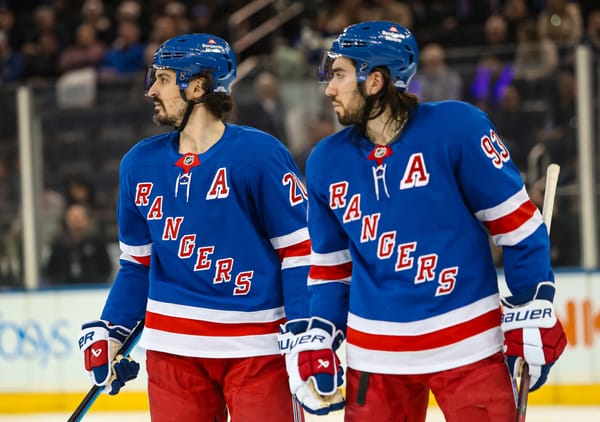2014 Report Card: Brad Richards was still productive in spite of his ludicrous contract
At the end of the day, Glen Sather was forced to buy out Brad Richards because of his own decision making, and not Richards' performance.
The lasting memory of Brad Richards' Rangers tenure will likely be sliding down the depth chart during New York' 2014 run to the Stanley Cup round, only to be bought out in the weeks following the Blueshirts championship loss. So while Richards last season in New York is easy to chalk up to an unproductive failure that was hardly the case.
Regular season production and consistency
Through the first third of the Rangers season, a lackluster record was likely the case of a team that both lacked fluidity and healthy bodies. Rick Nash, Ryan Callahan, Carl Hagelin, and Henrik Lundqvist all were sidelined at one point or another for some kind of ailment. Richards, however, was one of three Rangers (along with Derek Stepan and Brian Boyle) who appeared in all 82 of the team's games. He scored five goals in the Rangers' first five contests, and eight points in the first eight. The Rangers struggled out of the gate on a nine-game road trip, but one of the main reasons they stayed somewhat afloat was Richards.
And his production didn't exactly tail off. Sure, he didn't continue at a goal-per-game pace, but he did register 20, good enough for second on the team behind Rick Nash (not counting Martin St. Louis). His 31 assists were third highest among all Rangers, as were his 51 points. In the entire league, only 44 centers scored 20 or more goals this season. So while again, many don't shed the most favorable light on Richards, he produced well within the Ranger of a number two center.
Richards also managed to be a very solid possession player despite playing on inconsistent lines all season. With a CF% of 54.1, and rel CF% of 2.5, Richards was a big part of the Rangers possession renaissance under Alain Vigneault.
The power play, and the postseason
There's another thing that should be made clear about Richards: Had he performed at a certain level, and a buyout would have been felonious. Granted, with the term and dollars left on his deal that level would have had to be ridiculously high, but it still existed. And with that being said, the Achilles heel (or heels) for Richards in his final season in New York were the power play, and then the entire postseason.
In fairness to Richards, his power play struggles may have been more a direct result of personnel issues than his lack of skills. Richards is still a good passer, and really belonged on the half-wall where he could maneuver or go to goal. But lacking that big shot on the point, Richards found himself on the Rangers top power play unit next to Ryan McDonagh.
It was a tough spot for Richards for a number of reasons. For any forward occupying that blue line spot on the power play there has to be a certain level of reservation considering he becomes the last line of defense. With Richards, he also didn't have a big enough shot to be effective from that distance, or to make the penalty kill really worry about what he's capable of.
For Richards and the Rangers power play it didn't work out, but it's tough to exclusively pin the blame on him.
Then came the postseason, where things went all the way south for Richards. The one bright moment had to be his Game 7 winner against the Penguins to complete a round two comeback. Outside of that tally, it was a very forgettable 25 games for Richards. The goal against the Penguins was his fourth of the playoffs, and he scored in the very next game in the Game 1 rout of Montreal, but then went goalless in the Rangers final 10 postseason contests.
What was the difference between Richards and say, Nash? The latter was playing defensively accountable hockey and creating scoring chances, while Richards struggled with gap discipline, to be in the right spot at the right time, and to maintain possession. His CF% dipped to 44.7, and his rel CF% down to -4.4.
The not-so-good, very bad contract, and its buyout
When it came time to make a decision in the six remaining years of Richards' contract, there was really only one option for Sather: buyout. Richards was slated to make $24 million over the next three years, the type of money paid to one of the top centers in the league. (The top money-getter on this year's open market was Paul Stastny, who's new deal had an AAV of $7 million.)
Sather dug himself into this hole by giving Richards a nine-year, $60 million deal that paid Richards 95 percent of the salary over the first six, and filled that hole using the Rangers second compliance buyout. Richards and the Rangers divorce was always about the money, and not performance.
Grade Richards season
| A | 20 |
| B | 216 |
| C | 183 |
| D | 39 |
| F | 9 |
| Didn't see him enough. | 5 |




